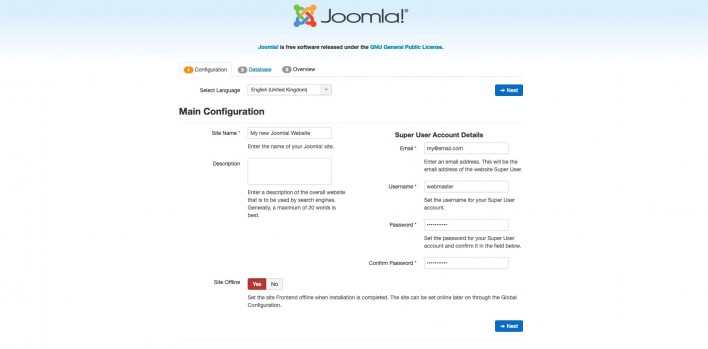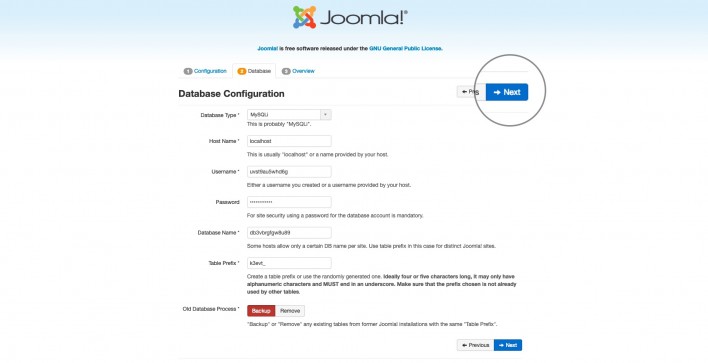How to Install Joomla?
This tutorial explains how to install Joomla! manually on your web hosting account. We focus on the installation of Joomla! 3, as it is the latest stable branch officially recommended for all new projects.
Download the Needed Joomla 3 Installation Package
To start a Joomla! installation on a web server, first you need to download the Joomla! installation package. We recommend that you download Joomla! only from the official website of the application – downloads.joomla.org. If you download the Joomla 3 installation package from other than the official one, there is a risk of malicious code in the setup files.
Once you click on the Download button for the latest Joomla! version, the installation package will be saved to your hard disk. Locate the installation package (should be named Joomla_X.X.X-Stable-Full_Package.zip or similar) that you’ve just downloaded and extract it to a new folder.
Upload the Joomla! Files to Your Server
Now, you need to upload the extracted files and folders to your web server. The easiest way to upload the Joomla! installation files is via FTP. For detailed information on how to upload files via FTP, you can check our FTP Tutorial.
Create a MySQL Database for Joomla to Use
Next, create a MySQL database and assign a user to it with full permissions. Once you create your MySQL Database and User, make sure you write down the database name, database username and password you’ve just created. You will need those for the installation process.
Go Through the Installation Process
If you have uploaded the installation files, open your browser and navigate to your main domain (i.e. http://mydomain.com), or to the appropriate subdomain (i.e http://mydomain.com/joomla), depending on where you have uploaded the Joomla! installation package. Once you do that, you will be taken to the first screen of the Joomla! Web Installer. On the first step of the installation process, you need to add the necessary information about your site and your administrative username.

- Site Name: Enter the name of your site. Most templates will use this for the first heading of your index.
- Description: Add a brief description of your website. It depends on your template if and where this text would be displayed.
- Email: Enter a valid email address. It will be used for password recovery and system messages.
- Username: Your administrative username. Please select a unique username, rather than “admin” or “administrator” since those are often subject to hacker attacks.
- Password: Add a password as strong as possible.
- Site Offline: Select whether your site should be taken offline after you complete the installation. For the purpose of this tutorial, we will leave this option set to NO (site will be live after installation).
Once you fill in all the required fields, press Next to proceed with the installation.
On the next screen, you will have to enter the necessary information for your MySQL database.

- Database Type: By default, this value is set to MySQLi. Leave it that way, MySQLi is an optimized version of the regular MySQL database and it is supported on SiteGround servers.
- Host Name: Once again, leave the default localhost value.
- Username: Enter the username for your MySQL database
- Password: Fill in the password for the database username
- Database Name: Enter the name of the MySQL database you want to use
- Table Prefix: Joomla! will add this prefix to all of its database tables. This is useful if you want to host multiple Joomla sites on a single database. You should leave the default value.
- Old Database Process: If you have any existing databases, choose what to do with the existing tables that are required by the installer. The options are to remove or backup any existing data that’s about to be replaced. We recommend that you leave this option set to Backup since it is the safest choice.
After you enter all the necessary information, press the Next button to proceed.
You will be forwarded to the last page of the installation process. On this page, you can specify if you want any sample data installed on your server. For beginners, we recommend you to choose the Default Sample data option since it will serve as an example/backbone, that you can use to build your actual website. Note that you can delete all sample articles, menus, etc. at any time.

The second part of the page will show you all pre-installation checks. The SiteGround servers meet all Joomla! requirements and you will see a green check after each line.

Finally, press Install to start the actual Joomla! installation. In a few minutes, you will be redirected to the last screen of the Joomla! Web Installer.
On the last screen of the installation process, you need to press Remove “installation” folder. This is required for security reasons, so no one can reinstall your existing site later on. Note that Joomla! won’t let you use your site unless you remove this folder completely!



